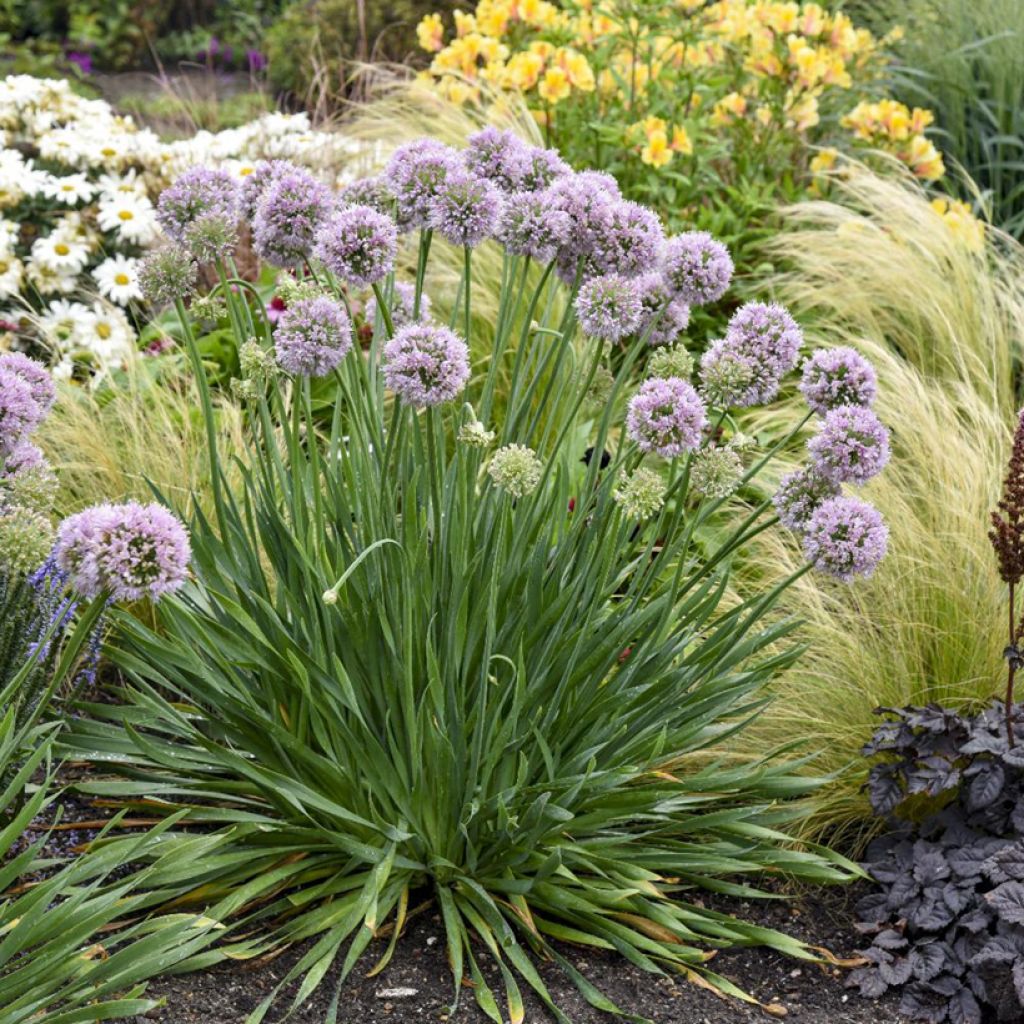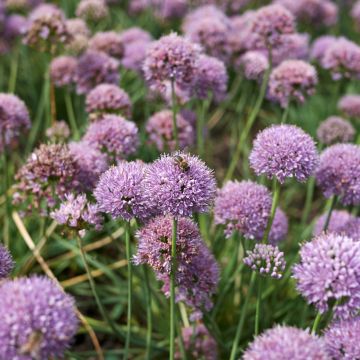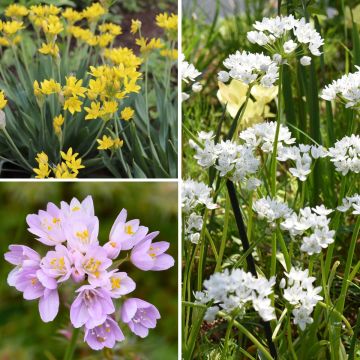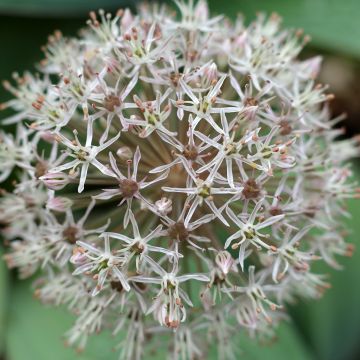

Allium Bubble Bath - Blue Siberian Onion
Allium Bubble Bath - Blue Siberian Onion
Allium nutans x senescens Bubble Bath ®
Blue Siberian Onion, Siberian Blue Onion, Nodding Onion.
This item cannot be shipped to the selected country
Delivery charge from €5.90
More information
Schedule delivery date,
and select date in basket
This plant carries a 12 months recovery warranty
More information
We guarantee the quality of our plants for a full growing cycle, and will replace at our expense any plant that fails to recover under normal climatic and planting conditions.
From €5.90 for pickup delivery and €6.90 for home delivery
Express home delivery from €8.90.
Does this plant fit my garden?
Set up your Plantfit profile →
Description
Allium Bubble Bath is a vigorous and prolific allium, quickly forming a dense clump of slightly twisted, glaucous green leaves. Unlike bulbous varieties, its foliage persists throughout the summer, remaining ornamental even after flowering. Its soft pinkish-purple ball-shaped inflorescences, which appear from July onwards, attract numerous pollinating insects. As easy to grow as a perennial, this garlic prefers a sunny exposure and ordinary, well-drained soil. It is perfect along a pathway, in a border, or even in a planter on a terrace. Moreover, its flowers are suitable for creating bouquets, whether fresh or dried.
Allium Bubble Bath is a hybrid ornamental garlic variety obtained in 2023 by Walters Gardens in Michigan. All these plants belong to the Alliaceae family, they are cousins of garlic and leeks with which they share a foliage with a characteristic scent, noticeable when crushed.
The Bubble Bath cultivar develops in spring from a rhizome that forms a beautiful clump of upright, rather thin, linear, shiny, bluish-green leaves. It reaches about 60 cm in height and spreads laterally through its slightly suckering rhizome, at least 50 cm. Flowering takes place in July-August in a moderate climate, lasting 5-6 weeks. From the centre of the clumps, 55 cm tall stems emerge, each bearing a solitary spherical inflorescence of 7 to 8 cm in diameter. The inflorescence is composed of numerous tiny star-shaped flowers in a very bluish-pink, purple hue, nectar-rich and honey-producing.
Planted en masse along a pathway, in a border or paired with perennials in pink and blue tones, the Bubble Bath allium stands out in a romantic mixed border. It wonderfully complements daylilies, bellflowers, Agastaches, catmints. In an original border mixing flowers and vegetables, it pairs well with chives, colourful-stemmed chards, Pennisetum x advena Rubrum, purple basil, and many more. For a more contemporary and dynamic effect, its flowers can structure a modern garden, playing on geometric shapes with Stipa tenuifolia, lavenders and boxwoods trimmed into cones.
Report an error about the product description
Flowering
Foliage
Plant habit
Botanical data
Allium
nutans x senescens
Bubble Bath ®
Alliaceae
Blue Siberian Onion, Siberian Blue Onion, Nodding Onion.
Cultivar or hybrid
Other Allium
Planting and care
Bubble Bath alliums are easy-to-grow plants in full sun and well-drained soil that doesn't retain too much water. Preferably plant them before the end of October so they have time to establish themselves well. They dislike excessive winter moisture. Bubble Bath Garlic is grown and planted like a perennial. It enjoys the sun and thrives in any good, well-drained garden soil. In clay soil, incorporate some gravel or sand. It is hardy and not very demanding in water, but appreciates the soil staying slightly moist in summer to support its flowering. Ornamental garlic bulbs, unlike tulip bulbs, repel rodents. These plants have few enemies in our gardens.
Planting period
Intended location
Care
This item has not been reviewed yet - be the first to leave a review about it.
Haven't found what you were looking for?
Hardiness is the lowest winter temperature a plant can endure without suffering serious damage or even dying. However, hardiness is affected by location (a sheltered area, such as a patio), protection (winter cover) and soil type (hardiness is improved by well-drained soil).

Photo Sharing Terms & Conditions
In order to encourage gardeners to interact and share their experiences, Promesse de fleurs offers various media enabling content to be uploaded onto its Site - in particular via the ‘Photo sharing’ module.
The User agrees to refrain from:
- Posting any content that is illegal, prejudicial, insulting, racist, inciteful to hatred, revisionist, contrary to public decency, that infringes on privacy or on the privacy rights of third parties, in particular the publicity rights of persons and goods, intellectual property rights, or the right to privacy.
- Submitting content on behalf of a third party;
- Impersonate the identity of a third party and/or publish any personal information about a third party;
In general, the User undertakes to refrain from any unethical behaviour.
All Content (in particular text, comments, files, images, photos, videos, creative works, etc.), which may be subject to property or intellectual property rights, image or other private rights, shall remain the property of the User, subject to the limited rights granted by the terms of the licence granted by Promesse de fleurs as stated below. Users are at liberty to publish or not to publish such Content on the Site, notably via the ‘Photo Sharing’ facility, and accept that this Content shall be made public and freely accessible, notably on the Internet.
Users further acknowledge, undertake to have ,and guarantee that they hold all necessary rights and permissions to publish such material on the Site, in particular with regard to the legislation in force pertaining to any privacy, property, intellectual property, image, or contractual rights, or rights of any other nature. By publishing such Content on the Site, Users acknowledge accepting full liability as publishers of the Content within the meaning of the law, and grant Promesse de fleurs, free of charge, an inclusive, worldwide licence for the said Content for the entire duration of its publication, including all reproduction, representation, up/downloading, displaying, performing, transmission, and storage rights.
Users also grant permission for their name to be linked to the Content and accept that this link may not always be made available.
By engaging in posting material, Users consent to their Content becoming automatically accessible on the Internet, in particular on other sites and/or blogs and/or web pages of the Promesse de fleurs site, including in particular social pages and the Promesse de fleurs catalogue.
Users may secure the removal of entrusted content free of charge by issuing a simple request via our contact form.
The flowering period indicated on our website applies to countries and regions located in USDA zone 8 (France, the United Kingdom, Ireland, the Netherlands, etc.)
It will vary according to where you live:
- In zones 9 to 10 (Italy, Spain, Greece, etc.), flowering will occur about 2 to 4 weeks earlier.
- In zones 6 to 7 (Germany, Poland, Slovenia, and lower mountainous regions), flowering will be delayed by 2 to 3 weeks.
- In zone 5 (Central Europe, Scandinavia), blooming will be delayed by 3 to 5 weeks.
In temperate climates, pruning of spring-flowering shrubs (forsythia, spireas, etc.) should be done just after flowering.
Pruning of summer-flowering shrubs (Indian Lilac, Perovskia, etc.) can be done in winter or spring.
In cold regions as well as with frost-sensitive plants, avoid pruning too early when severe frosts may still occur.
The planting period indicated on our website applies to countries and regions located in USDA zone 8 (France, United Kingdom, Ireland, Netherlands).
It will vary according to where you live:
- In Mediterranean zones (Marseille, Madrid, Milan, etc.), autumn and winter are the best planting periods.
- In continental zones (Strasbourg, Munich, Vienna, etc.), delay planting by 2 to 3 weeks in spring and bring it forward by 2 to 4 weeks in autumn.
- In mountainous regions (the Alps, Pyrenees, Carpathians, etc.), it is best to plant in late spring (May-June) or late summer (August-September).
The harvesting period indicated on our website applies to countries and regions in USDA zone 8 (France, England, Ireland, the Netherlands).
In colder areas (Scandinavia, Poland, Austria...) fruit and vegetable harvests are likely to be delayed by 3-4 weeks.
In warmer areas (Italy, Spain, Greece, etc.), harvesting will probably take place earlier, depending on weather conditions.
The sowing periods indicated on our website apply to countries and regions within USDA Zone 8 (France, UK, Ireland, Netherlands).
In colder areas (Scandinavia, Poland, Austria...), delay any outdoor sowing by 3-4 weeks, or sow under glass.
In warmer climes (Italy, Spain, Greece, etc.), bring outdoor sowing forward by a few weeks.














































